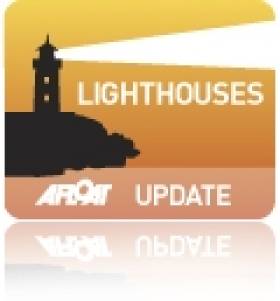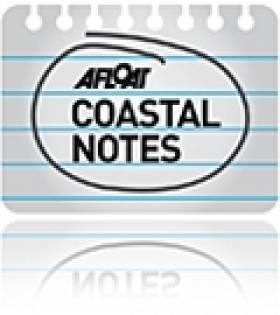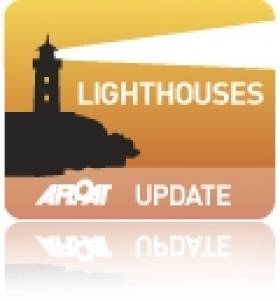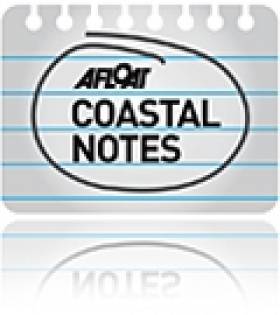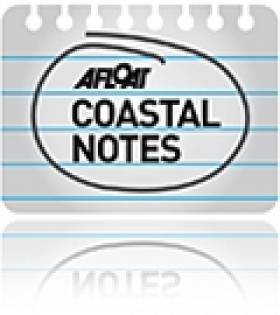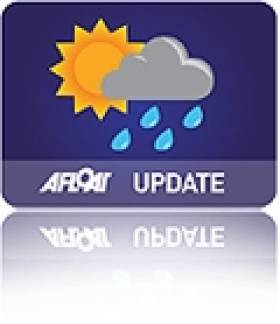Displaying items by tag: Clare
Doolin Pier Visitor Facility & Masterplan Announced
#doolin – Clare County Council has announced plans to develop a Visitor Services facility at Doolin Pier as part of an overall masterplan for the development of shoreline facilities in the County Clare coastal village.
The Council says the proposed facility will replace existing temporary structures and will be part of a masterplan relating to the development of the Doolin Pier area including the pier area in general, vehicle routes to and from Doolin village, and parking and traffic management.
Among the functions and operations considered within the overall plan will be sale of tickets by a number of Ferry Operators, the serving of food, and the provision of toilet facilities for patrons and staff, public waiting area, luggage holding area, tourism information, car/bike parking, waste management, harbour master office and health & safety requirements.
A new €6m pier is currently under construction and is nearing completion, according to the Council. The project is on target for completion by mid-2015. An estimated 70,000 to 90,000 passengers are carried annually by Doolin-based ferry operators.
"I welcome the steps being taken by Clare County Council to develop a visitor facility at Doolin which has been long sought after by users of the pier," stated Cllr. John Crowe, Cathaoirleach of Clare County Council.
"Once completed this summer, I have no doubt that the pier will help to drive ferry activity between North Clare and the Aran Islands and the Cliffs of Moher during the tourist season, as well as accommodate other activities – both leisure based and otherwise. It is important that such significant transport infrastructure is complemented by important ancillary services and facilities as proposed in this masterplan," said Cllr. Crowe.
Clare County Council is presently undertaking a tender process to appoint a Design consultancy team to design the masterplan for the Doolin Pier area.
"Doolin Pier is a gateway to the Aran Islands and is a major economic location in the North Clare area. The investment in the new pier will increase visitor numbers to the North Clare area and it is important therefore, that the necessary services are in place to accommodate this growth," Tom Coughlan, Chief Executive, Clare County Council.
Mr. Coughlan noted that the Visitor Services facility is the priority element of the brief, to be delivered initially as a "sustainable standalone project" capable of future integration within the overall masterplan.
"As part of the service provision by the successfully appointed design team, a full design brief will be developed through design research and via a consultation process. It is anticipated that the new development will enhance visitor numbers to Doolin and the Aran Islands by facilitating easier and more ordered parking, ticket sales and pier operations. This is all part of the Council's major commitment to providing improved infrastructure and services at Doolin Pier," said Mr. Coughlan.
Clare Council to Purchase Lough Derg's Holy Island
#holyisland – Clare County Council today confirmed that it is an advanced stage of negotiations to secure the purchase of Holy Island (Inis Cealtra) on Lough Derg, the largest lake on the River Shannon.
Holy Island is one of the most important historical and ecclesiastical sites in Ireland, has important links to Brian Ború and is known throughout East Clare as the "Jewel of the Lough'. The island comprises some 50 acres of which more than 4 acres are in the ownership of the Office of Public Works (OPW).
Still used as a burial ground, the ruins and buildings still standing on Holy Island date back as far as the 7th century when the monastic site was established by St. Caimin. Buildings on the island include a 24-metre high Round Tower, an Oratory, and a number of churches. The Island lies close to the village of Mountshannon and is on the UNESCO World Heritage site tentative list as an Early Medieval Monastic site along with Clonmacnoise, Durrow, Glendalough, Kells and Monasterboice.
Cllr. John Crowe, Cathaoirleach of Clare County Council expressed his delight that discussions are at an advanced stage and said he is "confident the acquisition of this important site can be completed."
The Cathaoirleach added: "I briefed the Tourism Minister, Mr. Pascal Donohue, T.D., on the current status during his recent visit to Clare and I also have been in contact with the Minister for Arts, Heritage and the Gaeltacht and the Minister of State with responsibility for the OPW who already own land on the island. It would be tremendous to secure public ownership of Holy Island this year, considering it is the millennial anniversary of the death of Brian Ború."
"My Council colleagues as well as Clare's six Oireachtas members are very supportive of public ownership of this important site," he added.
Gerard Dollard, Director of Services, Clare County Council confirmed that the acquisition of the island has been under consideration for a number of years and that an opportunity recently arose to bring the site into public ownership.
"We are fully aware of the significance of this location and would be anxious to see it forming part of the local tourism product and available to the wider public," explained Mr. Dollard.
He continued: "We are conscious of the strong heritage, environmental and conservation considerations associated with the Island and for that reason have commenced the preparation of terms of reference for a visitor management plan on how the untapped potential of this site can be realised. A critical first step is to secure public ownership and we look forward to receiving ongoing Government support for this initiative."
Loop Head Lighthouse Visitor Numbers Up
#loophead – One of Clare's newest and most popular tourism attractions, Loop Head Lighthouse has recorded an increase in visitor numbers this summer compared to 2013.
New figures show that the expansion of services at Shannon Airport and the designation of the West Clare tourism landmark as one of the discovery points along the route of the Wild Atlantic Way is having a positive impact on visitor numbers.
Figures released today by Clare County Council, which manages the facility in conjunction with the Commissioners of Irish Lights (CIL), reveal that 7,732 people have visited the 19th century lighthouse since it was opened for the summer period in late April, representing a 4% increase on the same period in 2013.
The local authority says 57% of the total visitor figure was represented by domestic visitors, with North America, Germany and the United Kingdom accounting for 10%, 9% and 6% of the overall figure respectively. Italian and French visitors meanwhile, represent just over 5% of the total figure.
Martin Gleeson, Supervisor at Loop Head Lighthouse commented: "This is fantastic news for the Lighthouse and the wider Loop Head Peninsula when you consider we are only now entering the peak tourism season. The launch of the Wild Atlantic Way, the development of new services at Shannon Airport, and the upgrading of visitor facilities at the lighthouse have been significant contributory factors to the growth in visitors. There is a noticeable increase in visitors from Germany and North America with the French and Italian markets also appearing particularly strong."
"The success of the Loop Head Lighthouse visitor project is indicative of the wider Peninsula's increasing popularity as a sustainable, visitor destination," added Kathy Lordan, Tourism & Community, Clare County Council.
Ms. Lordan continued: "The Council maintains a positive working relationship with local communities and indeed, Loop Head Tourism in developing, managing and showcasing the wonderful tourism assets on offer at the Peninsula from Loophead Lighthouse to the Bridges of Ross to Kilkee Bay. I am sure the marketing of the Peninsula and continued investment in the local tourism infrastructure that numbers visiting the area will show further increases during the remainder of the summer season and in future years."
Loop Head Lighthouse, located at the mouth of the Shannon Estuary, is steeped in history and rich in maritime heritage with its origins dating back to the 1670s. The existing tower style lighthouse was constructed in 1854 and was operated and maintained by a keeper who lived within the lighthouse compound.
Taoiseach Enda Kenny's grandfather was a keeper at the lighthouse. James John McGinley took up duty at the Lighthouse as Principal Keeper on 16th January 1933. He spent 1 year and 10 months at Loop Head. He was transferred from the station in October 1934. In January 1991, the lighthouse was converted to automatic operation, and today is in the care of an attendant and is also monitored by the CIL.
Loop Head Lighthouse will remain open daily (10am-6pm) until the end of September. Admission, which includes the exhibition and guided tour of the site, is Adults (€5), Children (€2) and Family Passes for up to 2 adults + 3 children (€12). Visit www.loophead.ie or www.clare.ie for more information on Loop Head Lighthouse and the Loop Head Peninsula.
Seaweed Theme in Burren Slow Food Festival
#slowfood – Food critic Sally McKenna, TV chef Darina Allen and food writer Dr. Prannie Rhatigan are among the participants in the 2014 Burren Slow Food Festival, details of which were announced today.
Supported by the Burren & Cliffs of Moher Geopark and also featuring members of the Burren Food Trail and the Burren Adventure, the 8th annual festival takes place in Lisdoonvarna, Co. Clare, on the weekend of 24-25 May.
Seaweed is a common theme across the Festival Programme this year.
Author of "Irish Seaweed Kitchen", Prannie Rhatigan GP is hosting a demonstration and talk on how the thousands of tonnes of seaweed washed up on Irish coastline each day can be exploited for their potential as a foodstuff.
Meanwhile, Sally McKenna of John and Sally McKennas' Guides (formerly The Bridgestone Guide) and Stefan Kraan, author of "The Science and Gastronomy of Umami", will be discussing the benefits for Ireland's seafood industry in harvesting seaweed.
The festival also features food sampling of local artisan foods, a chance to meet local producers and growers, engage with fellow foodies, and enjoy cookery demonstrations from well-known chefs including Jess Murphy, Kai Restaurant, Galway; John Sheedy, Sheedy's, Lisdoonvarna; and Aidan McGrath, Wild Honey Inn, Lisdoonvarna.
Other highlights of the weekend include a talk by Slow Food Ireland President and chef Darina Allen; a Wild Food Foraging Walk hosted by Oonagh O'Dwyer from Wild Kitchen in Lahinch; and a demonstration of the essential skills of making handcrafted fine chocolates by Burren Chocolatier and Burren Food Trail Kasha Connolly.
The main festival banquet on Saturday night will be prepared by Vivian Kelly of Kierans Kitchen at the Roadside Tavern who will serve Gleninagh Lamb, Burren Smoked Irish Organic Salmon, desserts from Fabiola's Pâtisserie and wines from Burren Fine Wine & Food.
#burren – The successful management and promotion of the Burren and Cliffs of Moher Geopark as a sustainable destination has been officially recognised by one of the world's foremost tourism and travel award schemes.
The World Travel & Tourism Council (WTTC) has named the Geopark as one of 18 finalists for its 2014 Tourism for Tomorrow Awards, the winners of which will be announced at a tourism summit in Hainan, China tomorrow (Thursday, 24 April 2014).
Carol Gleeson, Project Manager for Burren and Cliffs of Moher Geopark has travelled to China for the WTTC ceremony and tourism summit which is also being attended by Minister for Transport, Tourism and Sport, Mr Leo Varadkar TD.
The Tourism for Tomorrow Awards are one of the highest accolades in the global Travel & Tourism industry recognising sustainable tourism best practices in businesses and destinations worldwide, ranging from local destinations to global hotel groups, international airlines, luxury tour operators and small eco-lodges.
Award applications were received this year from 56 countries, representing all continents. The Burren and Cliffs of Moher Geopark has been shortlisted alongside Bonito (Brazil) and Temes S.A. - Costa Navarino (Greece) as 'Destination Award' finalists for "showing commitment to supporting and delivering sustainable tourism best practices in their destinations."
Speaking ahead of tomorrow's ceremony in Hainan, Carol Gleeson said the award nomination is testament to the partnership approach to promoting sustainable tourism in the Burren that has been developed by regional development agencies and the local community.
She explained: "Since 2008, Clare County Council has been working in the Burren to develop a truly sustainable tourism destination that gives direct benefits to the local community, promotes and celebrates local culture and produce, preserves the environment and provides a great experience for our visitors. This has been achieved with great support and partnership from local communities and businesses and agencies responsible for tourism and conservation and local development."
"This work includes establishing the Burren Ecotourism Network as far back as 2008, achieving UNESCO recognised Global Geopark status in 2011 and providing environmental and business training, developing a destination brand, promoting certification, and importantly linking high responsible tourism standards with economic benefit to the area. The Geopark has also attracted €2.2m funding through the EU Life programme to develop an international sustainable tourism destination model," Ms. Gleeson added.
According to Costas Christ, Chairman of the Judging Panel: "Each year, the Tourism for Tomorrow Awards recognize sustainable tourism best practices in action, helping to transform the Travel & Tourism industry based upon the principles of environmentally friendly operations, support for the protection of cultural and natural heritage, and direct benefits to the social and economic well-being of local people in travel destinations around the world. This year's Finalists continue to demonstrate that when carefully managed, tourism can be a powerful force for improving livelihoods and protecting our planet for future generations."
Further information on the Burren & Cliffs of Moher is available on www.burrengeopark.ie.
#DoolinPier – A new Atlantic seaboard pier sought by ferry operators and fishermen at Doolin in County Clare is expected to be completed by mid-2015 following the signing of a major marine infrastructural project today.
Brendan Howlin, T.D., Minister for Public Expenditure and Reform was in Doolin this afternoon to visit the location of the proposed €6m pier project for the County Clare coastal village.
Minister Howlin's visit coincided with the signing by Clare County Council of a contract with L&M Keating, the successful tenderer for the construction of the new pier. Construction work will begin in the coming days and is expected to be completed by mid-2015.
Mayor of Clare Cllr. Joe Arkins commented: "This project has been long sought after by ferry operators, fishermen and tourists who use the pier. The new pier development will boost visitor numbers in Clare considering access to the Aran Islands from the County will be greatly enhanced once the project is completed."
He added: "The completed pier will be used mainly to facilitate ferry activity between North Clare and the Aran Islands and the Cliffs of Moher during the tourist season while the existing pier will be available to accommodate other activities – both leisure based and otherwise. The new pier will ensure that Doolin is accessible in all tidal conditions, which will be of particular benefit to Doolin Search and Rescue as well as the ferry operators."
"I want to congratulate Clare County Council and its consultants who have worked closely with interested parties in ensuring that the completed pier brings a wide range of benefits to its users and the wider community," said Mayor Arkins.
Tom Coughlan, Clare County Manager added: "I am delighted that construction of this vitally important piece of infrastructure will commence shortly following years of open debate and extensive consultation with users of the pier, as well as the local community."
He continued: "The Local Authority has invested considerable time and resources into ensuring that the Doolin Pier project is one that benefits all users of the existing pier. Once completed, this project will have significant, positive economic and social consequences for the people of North Clare and the wider region. For example, the construction phase of the project will create jobs as will the increase in business that will arise as a result of the Pier's completion."
Tom Tiernan, Senior Engineer and Doolin Pier Project Manager stated: "I wish to pay tribute to the Council Consultants, led initially by Malachy Walsh and Partners, who guided the project from its inception through the various stages of planning, including the preparation of the Environmental Impact Statement (EIS) which facilitated An Bord Pleanala's decision in 2013 to give the go ahead for the construction of a new pier. I also want to thank Punch Consulting, who are leading the project through its tender and construction stages."
"The next stage of the Pier project is construction which will get underway almost immediately. L & M Keating Ltd, with whom Clare County Council signed a contract with today, is a well established Marine Works contractor and we look forward to working with the company. We anticipate that the project will be completed around mid 2015," concluded Mr. Tiernan.
Popular Loop Head Lighthouse Opens this Easter Weekend
The Loop Head Lighthouse in West Clare will reopen to the public this Saturday (April 19th 2014), Clare County Council has announced.
The Local Authority, which manages the facility in conjunction with the Commissioners of Irish Lights (CIL), says the historic lighthouse will remain open daily (10am-6pm) until the end of September.
The popular tourist attraction, which is one of two "Signature Discovery Points" in County Clare along the route of the recently launched Wild Atlantic Way, attracted 19,000 visitors during the six-month opening period in 2013. The figure represents an increase of 2,000 on the same period in 2012.
According to Mayor of Clare Cllr. Joe Arkins: "Loop Head Lighthouse has proven to be one of the tourism success stories for County Clare in recent years and has helped to strengthen the profile, both nationally and internationally, of the wider Loop Head Peninsula and what it has to offer as a tourism destination."
"I want to pay tribute to Clare County Council for its ongoing work to develop the lighthouse, particularly through the provision of a new interpretative space and exhibition which has added greatly to the overall visitor experience. I warmly welcome any efforts made to help County Clare maintain and grow a competitive advantage in tourism terms," he added.
Siobhan Garvey, Marketing and Development Officer for West Clare stated: "The public opening of Loop Head Lighthouse will provide a significant boost to the local tourism sector and the economy, which has benefited greatly since the attraction was first opened to the public in 2012. The fact that the attraction is opening on a 7-days-a-week basis from this Easter Bank Holiday Weekend is particularly timely as the Lighthouse is one of two local Discovery Points along the Wild Atlantic Way."
Loop Head Lighthouse, located at the mouth of the Shannon Estuary, is steeped in history and rich in maritime heritage with its origins dating back to the 1670s. The existing tower style lighthouse was constructed in 1854 and was operated and maintained by a keeper who lived within the lighthouse compound. In January 1991, the lighthouse was converted to automatic operation, and today is in the care of an attendant and is also monitored by the CIL.
Admission to Loop Head Lighthouse, which includes the exhibition and guided tour of the site, is Adults (€5), Children (€2) and Family Passes for up to 2 adults + 3 children (€12). Visit www.loophead.ie or www.clare.ie for more information on Loop Head Lighthouse and the Loop Head Peninsula.
Flood Risk Again for Coastal Clare
#coastalnotes – Clare County Council says it is monitoring the potential risk of coastal flooding later this weekend and on Monday.
The Council says that a tidal surge and accompanying Southwest to West winds will coincide with high spring tidal conditions during the 36-hour period from Sunday morning to Monday evening.
A Council spokesperson stated: "While conditions are not expected to deteriorate to the extent experienced in early January and early February, there is a potential for coastal flooding. We are continuing to liaise with Met Éireann and, if required, further advisories will be issued during the course of the weekend. In the meantime, caution is urged over the coming days in all areas where coastal flooding has previously occurred"
€16.8M Storm Fund Allocated to Clare County Council
#stormfund – Clare County Council last night (Thursday, 27 February 2014) received confirmation from the Department of the Environment, Community and Local Government of its decision to provide €16,205,637 to undertake repair works to local authority managed infrastructure damaged during the recent period of severe weather.
The funding has been allocated in response to submissions made to Government by Clare County Council outlining details of the structural damage caused to infrastructure along Clare's Atlantic coastline and at some locations along the Shannon Estuary.
The funding has been earmarked for a programme of repair works to roads, piers and harbours, coastal protection repairs, tourism infrastructure and other facilities which are in the charge of Clare County Council.
Meanwhile, the Department of the Environment, Community and Local Government has also made a once-off allocation of €608,878 to the local authority to recoup the costs associated with its response to storms during January.
Welcoming the news, Mayor of Clare Cllr. Joe Arkins said: "This is a very positive announcement for Clare and the people who live and work in the areas affected by the recent storms. I am delighted that Government has responded to the Council's detailed submissions with such a substantial funding allocation, which will help to alleviate the fears of many people who have expressed concern over what effect the storm damage would have on their communities and tourism infrastructure."
"Clare is a tourism county and is a key part of the Government tourism flagship project, the Wild Atlantic Way, and it is vitally important that our tourism product is accessible and usable. This allocation enables the Council to immediately prepare and submit a programme of works," added Mayor Arkins.
Clare County Manager Tom Coughlan has also warmly welcomed the announcement, adding: "Clare County Council is cogently aware of the importance of undertaking repair works to damaged infrastructure and has already invested a considerable amount of its own resources in undertaking interim remedial works to ensure that the impact of the storm damage on local communities has been minimised."
He continued: "In light of this extremely positive announcement, the Council will now begin a process of engagement with the relevant funding Departments and Agencies with a view to proceeding with vitally important infrastructure repair works along Clare coastline. We would hope that further funding allocations will be made but the level of this allocation enables very significant works to be progressed. Due to the extensive disruption to community life along the Clare coastline and in light of the upcoming summer tourist season, the local authority is committed to progressing the planning and delivery of repair works as quickly as possible."
The combined funding of €16,814,515 is in addition to the €6m already allocated by Government for the construction of a new harbour development, including a pier and flood defence works, at Doolin.
Severe Weather Alert Issued By Clare County Council
#weatherwarning – Clare County Council has issued a flood and storm warning for the entire county in advance of severe weather conditions that are expected during the next few days.
The local authority is urging land, home and business owners, particularly those in low lying coastal areas, to take precautionary steps in light of the flood risk posed by a combination of heavy rainfall, strong gale to storm force winds, a large sea swell and a Spring Tide.
"There is a serious risk countywide of both coastal and inland flooding and all areas which have flooded in the past could be seriously impacted. Conditions could be similar in nature and extent to the storm events of early January with the potential for structural damage," explained Tom Tiernan, Senior Engineer, Clare County Council.
He added: "Current firm indications are that severe weather conditions will pertain throughout the coming weekend commencing with a substantial rainfall event tomorrow (Friday). In addition, tide levels will be rising to a Spring Tide peak overnight on Friday/Saturday morning. This will be exacerbated by significant swell conditions and high Westerly and South Westerly winds which will continue through Saturday."
Mr. Tiernan confirmed that river levels remain "very high", and arrangements have been put in place to continuously monitor the situation.
He continued: "Clare County Council, in conjunction with the Emergency Services, is progressing contingency arrangements in terms of additional pumping capacity and other flood alleviation measures at flood prone locations. In the meantime, the advice is to take appropriate precautions and not to venture out unless necessary, particularly in coastal areas."
Flooding advice is available on www.flooding.ie . Information included on the website includes advice on identifying flooding risks, protecting property against flooding, necessary steps to be taken if a property is flooded, and assessing and repairing property damaged by flooding.




























